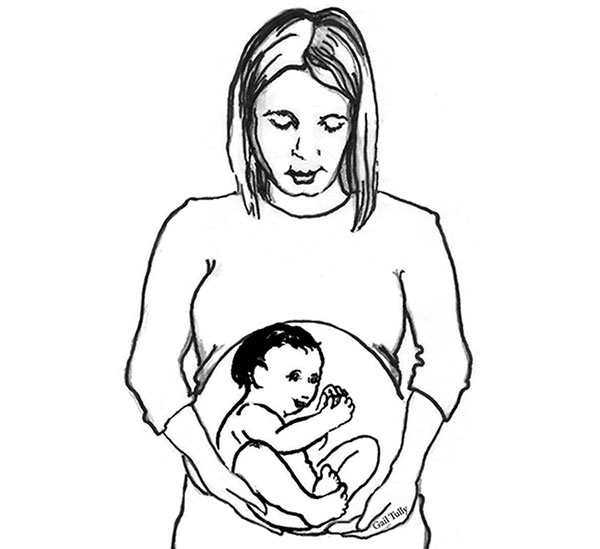To handle a breech baby, consult your healthcare provider for guidance. They may suggest several safe options.
A breech pregnancy occurs when the baby is positioned feet-first or buttocks-first in the womb. This can complicate delivery, so it’s crucial to understand your options. Typically, your doctor might recommend methods like external cephalic version (ECV) or a planned cesarean section.
ECV involves a professional manually turning the baby to a head-down position. If this isn’t successful, a C-section might be the safest route for both mother and baby. Knowing these steps can help you make informed decisions and ensure a safer delivery process. Always seek personalized advice from your healthcare provider to address your specific situation.
Introduction To Breech Babies
Expecting a baby is a wonderful journey. But finding out your baby is in a breech position can be worrying. This guide will help you understand breech babies and what to do.
The Basics Of Breech Position
A breech baby is positioned differently. Instead of the head being down, the baby’s bottom or feet are down. This happens in about 3-4% of full-term pregnancies.
| Breech Type | Description |
|---|---|
| Frank Breech | Baby’s legs are straight up, with feet near the head. |
| Complete Breech | Baby’s legs are folded, with feet near the bottom. |
| Footling Breech | One or both feet are positioned to come out first. |
Why A Breech Position Matters
A breech position can make childbirth more complicated. It can lead to a longer labor and potential delivery issues. Doctors may suggest a cesarean section for a breech baby.
Knowing the type of breech position helps doctors plan the best approach. This ensures the safety of both the mother and baby.
Understanding these basics can ease your worries. You’ll be better prepared to discuss options with your healthcare provider.
Identifying A Breech Baby
Understanding if your baby is breech is crucial for a safe delivery. A breech baby is positioned feet or buttocks first inside the womb. Knowing the signs can help you seek timely medical advice.
Signs And Symptoms
Recognizing the signs can aid in early detection. Here are some common symptoms:
- Baby’s head feels high in the belly.
- Movement feels lower in the pelvis.
- Heartbeats heard above the belly button.
- Hard lump felt under ribs, indicating the head.
These signs may suggest a breech position. Always consult your doctor for confirmation.
Confirming With An Ultrasound
An ultrasound is the most reliable way to confirm a breech position. Your doctor will use sound waves to create images of your baby inside the womb.
| Step | Description |
|---|---|
| 1 | Schedule an ultrasound appointment. |
| 2 | Attend the appointment as scheduled. |
| 3 | Doctor scans the baby’s position. |
| 4 | Receive confirmation of breech or not. |
Early identification and medical advice are key steps. This helps in planning the safest delivery method. Remember, regular prenatal visits are important for monitoring.
Types Of Breech Presentations
When your baby is breech, understanding the types of breech presentations is crucial. Different breech positions can affect your birth plan. Here, we’ll explain the three main types of breech presentations: Frank Breech, Complete Breech, and Footling Breech.
Frank Breech
In a Frank Breech position, the baby’s buttocks are aimed toward the birth canal. The legs are straight up, with feet near the head. This is the most common type of breech presentation. Check the table below for more details:
| Characteristic | Description |
|---|---|
| Position | Buttocks down, feet near head |
| Frequency | Most common breech type |
Complete Breech
A Complete Breech presentation means the baby is in a sitting position. Both the buttocks and feet are aimed toward the birth canal. The baby’s legs are bent at the knees. This position is less common than Frank Breech. Here are the key details:
| Characteristic | Description |
|---|---|
| Position | Buttocks and feet down, legs bent |
| Frequency | Less common than Frank Breech |
Footling Breech
In a Footling Breech position, one or both of the baby’s feet are aimed toward the birth canal. The feet are positioned to come out first. This type is rare and can be more challenging during delivery. Key points are shown below:
| Characteristic | Description |
|---|---|
| Position | One or both feet down |
| Frequency | Rare |
When To Seek Medical Advice
Having a breech baby can be stressful. Knowing when to seek medical advice is crucial. This guide will help you navigate the steps. It ensures you and your baby stay safe and healthy.
Recommended Timeframes
Understanding the best times to seek advice is key. Here are the recommended timeframes:
| Pregnancy Stage | Action |
|---|---|
| 28-32 weeks | Regular check-ups to monitor baby’s position |
| 34-36 weeks | Seek advice if baby is still breech |
| 36+ weeks | Discuss delivery options and potential interventions |
Choosing The Right Healthcare Provider
Choosing the right healthcare provider is important for a breech pregnancy. Here are some tips:
- Experience: Ensure your provider has experience with breech pregnancies.
- Communication: Choose someone who listens and answers your questions.
- Availability: Make sure they are available when you need them.
By following these steps, you can ensure you receive the best care. Your baby’s safety and your peace of mind are paramount.
Natural Methods To Turn A Breech Baby
Discovering your baby is in a breech position can be stressful. Luckily, there are natural ways to help turn your baby. These methods are safe and can be done at home. Here are some effective approaches to try.
Exercises And Techniques
Specific exercises can encourage your baby to move into the correct position. Here are some popular techniques:
- Forward-leaning Inversion: Kneel on the edge of a sofa. Lower your hands to the floor, creating an inverted position. Hold for 30 seconds, then slowly return to a kneeling position.
- Pelvic Tilts: Lie on your back with your knees bent. Lift your hips towards the ceiling. Hold for a few seconds, then lower your hips. Repeat this exercise 10 times daily.
- Cat-Cow Stretch: Get on all fours with your hands under your shoulders. Arch your back like a cat, then lower it like a cow. Repeat this 10 times, twice daily.
Alternative Therapies
Alternative therapies can also support turning a breech baby. Consider the following options:
- Acupuncture: A licensed practitioner uses fine needles to stimulate specific points. This therapy can encourage the baby to turn naturally.
- Moxibustion: This technique involves burning a herb near your toes. It creates warmth and encourages baby movement. Always consult an expert before trying this method.
- Chiropractic Care: The Webster technique is a chiropractic method. It helps realign the pelvis and may turn the baby. Make sure the chiropractor is certified in this technique.

Credit: www.wombrevolution.com
Medical Interventions
When your baby is breech, medical interventions can help. These interventions aim to turn the baby head-down or prepare for a safe delivery. Here are some common medical interventions for breech pregnancies.
External Cephalic Version (ecv)
External Cephalic Version (ECV) is a procedure to turn the baby. A doctor places hands on your belly. The doctor then gently pushes to turn the baby head-down.
ECV is often done around 37 weeks of pregnancy. This timing gives the baby enough time to turn. It also allows the baby to stay in the head-down position.
The success rate of ECV is about 50%. This means it works for half of the women who try it.
Risks And Considerations
Like all procedures, ECV has risks. Some women feel pain or discomfort. There is also a small risk of early labor. Rarely, ECV can cause changes in the baby’s heart rate. In such cases, an emergency C-section may be needed.
Doctors will use ultrasound to guide the ECV. This helps to see the baby’s position. It also ensures the procedure is safe.
Not all women are good candidates for ECV. Here are some factors that may affect eligibility:
- Placenta previa
- Low amniotic fluid
- Multiple pregnancies (twins, triplets)
- Uterine abnormalities
Discuss ECV with your doctor to understand if it’s right for you. They can explain the benefits and risks based on your situation.
Preparing For Delivery
Finding out your baby is breech can be overwhelming. Preparing for delivery is crucial. Understanding your options and making a plan helps ease anxiety.
Breech Birth Plan
Creating a breech birth plan is essential. Discuss all options with your healthcare provider. Know the risks and benefits of each method.
- Consider a vaginal breech birth if it’s safe.
- Make sure your provider has experience with breech births.
- Prepare for unexpected changes in your birth plan.
Cesarean Section Considerations
A Cesarean section may be recommended for a breech baby. Understand what this involves and prepare mentally and physically.
| Pros | Cons |
|---|---|
| Lower risk for baby | Longer recovery for mom |
| Planned and predictable | Higher surgical risks |
| Less stress during labor | Potential for future C-sections |
Talk to your doctor about the benefits and risks of a C-section. Make a list of questions and concerns to discuss during your appointment.
Post-delivery Care
Welcoming your breech baby into the world is a unique experience. After delivery, special care ensures your baby’s health and supports your recovery.
Monitoring The Baby’s Health
After a breech birth, the baby’s health needs close monitoring. Pediatricians check vital signs and physical health.
- APGAR Score: Doctors assess the baby’s heart rate, respiration, muscle tone, reflex response, and color.
- Hip Dysplasia: Breech babies have a higher risk of hip dysplasia. Doctors may order an ultrasound.
- Head Shape: Breech birth can affect the shape of the baby’s head. Regular checks ensure normal development.
Healthcare providers schedule follow-up appointments. This ensures the baby’s growth and development stay on track.
Support For Parents
Caring for a breech baby can be stressful. Support systems for parents are essential.
- Parental Leave: Check your eligibility for parental leave. This allows time to bond and recover.
- Support Groups: Join local or online support groups. Share experiences with other parents.
- Counseling Services: Consider professional counseling. It helps manage stress and emotional well-being.
Parents must also focus on self-care. Proper rest, nutrition, and mental health support are vital.
Emotional Support And Resources
Discovering your baby is breech can be stressful. You may feel a mix of emotions. Seeking emotional support is crucial during this time. Various resources can help you cope. These resources provide valuable information and a sense of community.
Counseling And Support Groups
Professional counseling can provide immense relief. A counselor helps you navigate your feelings. They offer strategies to manage stress and anxiety.
Support groups are another great option. Here, you connect with other expectant mothers. These groups offer a sense of solidarity. You learn from shared experiences.
- Local hospital support groups
- Online forums for breech pregnancies
- Community center meetings
Joining a support group can make you feel less isolated. You gain emotional strength from others. This support network is invaluable during a breech pregnancy.
Educational Materials And Online Communities
Access to educational materials is essential. These resources help you understand your options. Knowledge empowers you to make informed decisions.
Many websites offer free educational content. This includes articles, videos, and e-books. These materials cover various aspects of breech pregnancies.
| Resource Type | Description |
|---|---|
| Articles | Detailed information on breech pregnancy |
| Videos | Visual guides and expert interviews |
| e-Books | Comprehensive guides and tips |
Online communities also offer support. These platforms connect you with other parents. You can ask questions and share your experiences.
- Join forums dedicated to breech pregnancies
- Participate in social media groups
- Engage in live Q&A sessions with experts
These online communities are a treasure trove of information. They provide real-time support and advice. You can find comfort knowing you are not alone.

Credit: www.spinningbabies.com

Credit: www.pinterest.com
Frequently Asked Questions
What To Do When Fetus Is In Breech Position?
Consult your doctor for options. They may suggest exercises, external cephalic version, or a planned C-section. Stay informed.
How Do You Manage A Breech Pregnancy?
Doctors manage breech pregnancies through external cephalic version (ECV) or by planning a C-section. Consultation with an obstetrician is essential.
What Helps Baby Get Out Of Breech Position?
Several techniques can help turn a breech baby. Try pelvic tilts, prenatal yoga, or chiropractic care. Consult your doctor.
What Does It Mean If My Baby Is Breech?
A breech baby is positioned feet or buttocks first instead of head down. This can complicate delivery.
Conclusion
Navigating a breech pregnancy can feel overwhelming. Follow our step-by-step guide to make informed decisions. Always consult with your healthcare provider. Understanding your options ensures the best outcomes for you and your baby. Stay calm and proactive throughout the process.
Your health and your baby’s safety come first.

